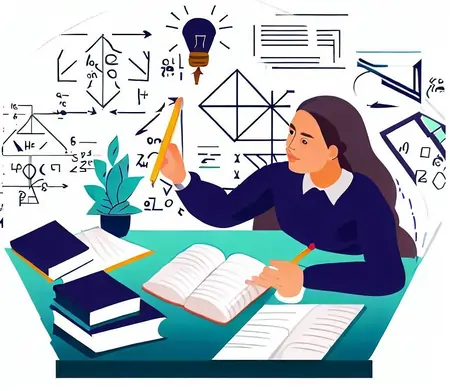Key Concepts and Successful Approaches for Solving Geometry Assignments

If you are working to complete your geometry assignment, it's important to have a solid grasp of certain fundamental topics and problem-solving techniques. In this blog post, we'll explore the key topics you should be familiar with before starting a geometry assignment and provide you with practical strategies to tackle geometry problems effectively.
Geometric Fundamentals: Building a Strong Foundation
Before you embark on solving complex geometry problems, it's essential to have a solid grasp of the fundamental concepts that form the backbone of geometry:
Points, Lines, and Planes
Understanding the basic elements of geometry such as points, lines, and planes is paramount. A point is a location with no size, a line extends infinitely in both directions, and a plane is a flat, two-dimensional surface. Being able to identify and distinguish between these entities is crucial.

Angles and Their Properties
Angles are formed when two rays share a common endpoint. Learn about different types of angles – acute, obtuse, right, and straight – and their properties. This knowledge will serve as the basis for understanding angle relationships and theorems.
Polygons and Their Characteristics
Polygons are closed shapes with straight sides. Familiarize yourself with various polygons, including triangles, quadrilaterals, pentagons, and hexagons. Understand their properties, interior angles, and exterior angles.
Euclidean Geometry: The Classical Approach
Euclidean geometry, named after the ancient Greek mathematician Euclid, provides a framework for understanding the relationships between geometric shapes and their properties:
Euclidean Postulates and Theorems
Euclid's axiomatic approach establishes a set of assumptions (postulates) from which geometric theorems are derived. Key postulates include the existence of a straight line between any two points and the congruence of triangles based on side-angle-side (SAS) and angle-side-angle (ASA) criteria.
Pythagorean Theorem
One of the most famous theorems in geometry, the Pythagorean theorem, relates the sides of a right triangle: the square of the hypotenuse is equal to the sum of the squares of the other two sides.
Similarity and Congruence
Understanding the concepts of similarity and congruence is vital. Similar figures have the same shape but possibly different sizes, while congruent figures are both the same shape and size.
Coordinate Geometry: Bridging Geometry
Coordinate geometry brings together algebraic techniques and geometric concepts, offering a powerful toolset for solving problems:
Cartesian Coordinate System
Familiarize yourself with the Cartesian coordinate plane, where points are represented by ordered pairs (x, y). This system allows you to plot points, find distances between points, and explore geometric relationships algebraically.
Distance and Midpoint Formulas
Learn how to calculate the distance between two points using the distance formula and how to find the midpoint of a line segment using the midpoint formula. These formulas are essential when dealing with coordinate geometry.
Geometric Proofs: The Art of Logical Deduction
Geometry is renowned for its emphasis on logical reasoning and proofs. Mastering geometric proofs is a key aspect of successfully handling geometry assignments:
Proof Techniques
Explore various proof techniques, such as direct proofs, proof by contradiction, and mathematical induction. Understand how to use these techniques to logically justify statements and theorems.
Triangle Congruence Proofs
Triangular congruence proofs involve demonstrating that two triangles are congruent based on specific criteria, such as side-angle-side (SAS) or angle-side-angle (ASA). Practice constructing these proofs step by step.
Transformations: Shaping the World Differently
Transformations provide a way to manipulate geometric shapes while preserving essential properties:
Translations, Rotations, Reflections, and Dilations
Understand the four fundamental transformations – translations (sliding), rotations (turning), reflections (flipping), and dilations (resizing) – and their effects on shapes. These transformations help in visualizing and analyzing geometric relationships.
Symmetry and Tessellations
Learn about symmetry and how shapes can be symmetrical across various axes. Delve into tessellations, patterns formed by repeating identical shapes without gaps or overlaps.
Strategies for Solving Geometry Assignments Effectively
Solving geometry assignments requires more than just theoretical knowledge. Here are strategies to tackle assignments with confidence:
Read and Understand Thoroughly
Before diving into solving a geometry assignment, take the time to thoroughly read and comprehend the problem statement. Pay close attention to the given information, constraints, and specific requirements outlined in the prompt. Break down complex sentences or instructions into smaller parts if needed. Understanding the problem deeply is crucial as it forms the foundation for your entire approach. Misinterpreting the problem can lead to incorrect solutions or unnecessary complications. By ensuring a clear grasp of the assignment's context and objectives, you'll be better equipped to strategize and apply the appropriate geometric concepts and techniques.
Draw Diagrams
Visual representation is a powerful tool in solving geometry problems. After understanding the problem, create accurate and well-labeled diagrams that illustrate the given information, relationships between geometric elements, and any additional constructions you might need. These diagrams help you visualize the scenario, identify patterns, and deduce relevant properties. Clear diagrams can also prevent mistakes caused by misinterpretation or confusion. They serve as a guide throughout your problem-solving process, aiding in making connections between different aspects of the problem. An intelligently constructed diagram can often provide insights that lead to more efficient problem-solving strategies and accurate conclusions.
Apply Relevant Theorems
Applying relevant theorems is a cornerstone of effective geometry problem-solving. When confronted with a problem, identify the theorems, postulates, and concepts that are directly applicable. These established principles provide a solid framework for reasoning and deriving conclusions. By recognizing the connections between the problem and existing theorems, you can streamline your approach and avoid reinventing the wheel. For instance, if you're dealing with congruent triangles, employ the corresponding parts of congruent triangles theorem to establish relationships between angles and sides. This strategic use of theorems not only enhances your problem-solving efficiency but also showcases your understanding of fundamental geometric principles. Remember to clearly reference the theorems you're using in your solution, demonstrating the logical progression of your reasoning.
Start with Known Information
Beginning with known information is a strategic approach to unraveling complex geometry problems. By identifying and leveraging the information provided in the problem statement, you establish a solid starting point for your solution. Start by carefully examining the given measurements, angles, lengths, or relationships between geometric elements. These known facts serve as building blocks upon which you can construct further insights and deductions. For example, if a problem presents a right triangle with one angle and a hypotenuse length, you can use trigonometric ratios to determine the lengths of the other sides. Starting with what you know not only gives you direction but also boosts your problem-solving confidence. As you progress, continue incorporating these established facts into your reasoning, step by step, until you arrive at a comprehensive solution.
Be Patient and Persistent
When tackling geometry assignments, it's crucial to maintain a patient and persistent mindset. Geometry problems can often be intricate and require careful analysis. Rushing through the process can lead to mistakes and oversights. By cultivating patience, you allow yourself the time to fully comprehend the problem, identify the relevant concepts, and formulate a thoughtful approach.
Additionally, persistence is key when encountering challenges or roadblocks. Some problems might not yield immediate solutions, and you might need to explore various angles and techniques before reaching the answer. Persistence encourages you to keep trying different approaches and seeking alternative methods, fostering a sense of determination that ultimately leads to successful problem-solving.
In the face of complex geometric puzzles, remember that progress might not always be linear. Embrace the journey of problem-solving, and approach each step with a calm and persistent attitude. Your willingness to stay patient and persistent will undoubtedly contribute to your success in conquering geometry assignments.
Check Your Answer
The final step in solving geometry assignments is to thoroughly review and validate your answer. This involves double-checking your calculations, ensuring that your solution aligns with the problem's requirements, and verifying the units and measurements you've used. By performing this step, you reduce the likelihood of errors and demonstrate a commitment to accuracy and precision.
Checking your answer is an essential part of the problem-solving process. It allows you to catch any potential mistakes or oversights before submitting your work. It's not uncommon for minor errors to slip through during calculations, and by dedicating time to review your solution, you can correct these mistakes and present a polished and well-executed assignment.
This practice not only showcases your attention to detail but also reinforces your understanding of the problem. It's an opportunity to ensure that your logical reasoning is sound and that your solution makes sense within the context of the assignment. By making checking your answer a habit, you enhance the quality of your work and your overall mastery of geometry problem-solving.
Conclusion
Embarking on a journey through the world of geometry assignments can be both challenging and rewarding. Equipped with a solid foundation of geometric fundamentals, Euclidean principles, coordinate geometry techniques, proof strategies, transformation insights, and problem-solving strategies, you're well-prepared to conquer the geometric realm.
Remember that practice is key. The more problems you tackle, the more confident and adept you'll become at maneuvering through the intricate landscapes of geometry. As you unravel the mysteries of shapes, lines, angles, and spaces, you're not only mastering the art of geometry but also honing your analytical thinking and logical reasoning skills – skills that transcend mathematics and serve you well in various aspects of life.